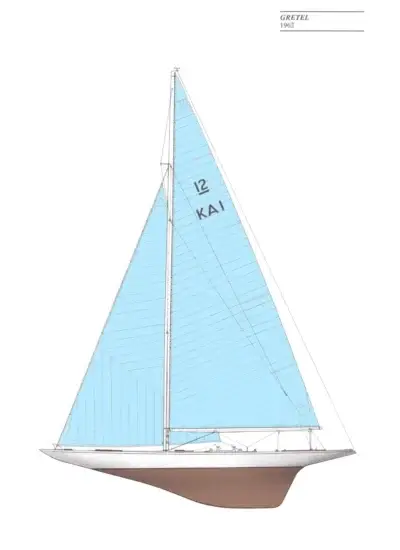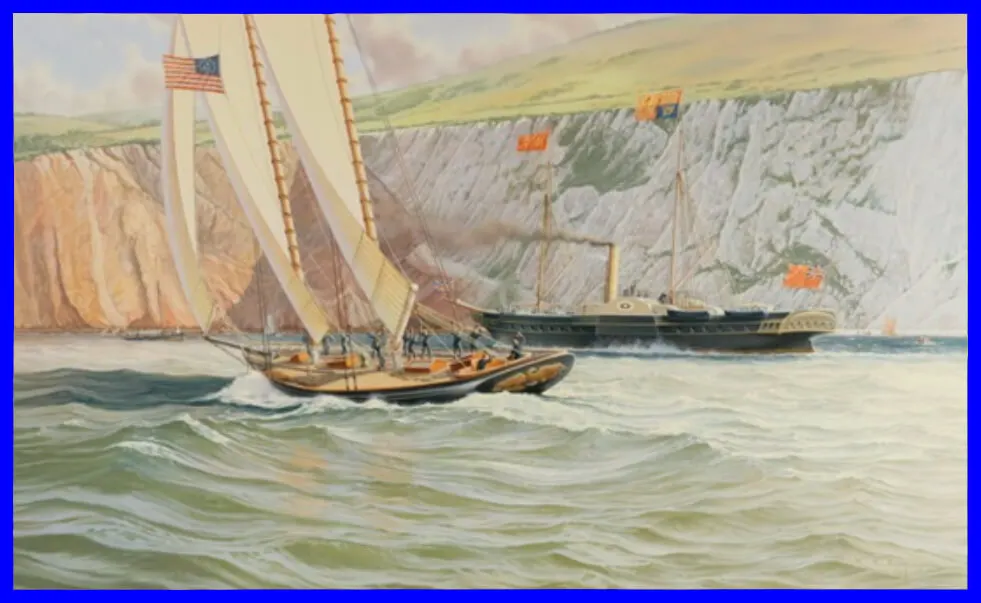America, 1851
£0.00America’s Cup Yachts 1851-1970
SOLD OUT NO MORE STOCK
Out of stock
Published 1971 by Hugh Evelyn; artist © John Gardner (1930-2010). Printed on white cardstock of 142 g/m².
Size: c. 23.5 cm x 33.5 cm (9¼” x 13¼″) but size may vary slightly. Images shown are scans.
Prints are STANDARD size. Shipping cost is the same for up to 10 prints of the largest size in an order – see Shipping and Returns
Cell/mobile users scroll down to read the story of the birth of the America’s Cup.
Showing all 16 results


Magic: New York Yacht Club, New York, NY, USA – defeated Cambria in 1870 (scroll down for a more detailed Description)
Print published 1971 by Hugh Evelyn Limited; drawn by Scottish marine artist © John Gardner (1930-2010)
Size: 33.5 x 23.5 cm [13 ¼″ x 9 ¼”] in landscape orientation (may vary slightly from printers’ cut 50 years ago)
Printed on white cardstock c. 142 g/sm2
Print is STANDARD size – shipping is the same for 1 to 10 prints (based on largest print size in your order) – see Shipping & Returns

Cambria: Royal Thames Yacht Club, London, UK; lost to Magic 1870 (scroll down for a more detailed Description)
Print published 1971 by © Hugh Evelyn; drawn by Scottish marine artist John Gardner (1930-2010).
Print size: 33.5 x 23.5 cm (13 ¼″ x 9 ¼”) in landscape orientation (may vary slightly from printers’ cut 50 years ago)
Printed on white cardstock c. 142 g/sm2.
Print is STANDARD size – shipping is the same for 1 to 10 prints (based on largest print size in your order) – see Shipping & Returns

Genesta: Royal Yacht Squadron, Cowes, Isle of Wight, UK; lost to Puritan (scroll down for a more detailed Description)
Print published 1971 by Hugh Evelyn Limited; drawn by Scottish marine artist © John Gardner (1930-2010)
Size: 33.5 x 23.5 cm [13 ¼″ x 9 ¼”] in landscape orientation (may vary slightly from printers’ cut 50 years ago)
Printed on white cardstock c. 142 g/sm2
Print is STANDARD size – shipping is the same for 1 to 10 prints (based on largest print size in your order) – see Shipping & Returns

Defender: New York Yacht Club, New York, NY, USA;defeated Valkyrie III in 1895 (scroll down for a more detailed Description)
Print published 1971 by Hugh Evelyn Limited; drawn by Scottish marine artist © John Gardner (1930-2010)
Size: 33.5 x 23.5 cm [13 ¼″ x 9 ¼”] (may vary slightly from printers’ cut 50 years ago)
Printed on white cardstock c. 142 g/sm2
Print is STANDARD size – shipping is the same for 1 to 10 prints (based on largest print size in your order) – see Shipping & Returns

Columbia: New York Yacht Club, New York, NY, USA;defeated Shamrock (1899) and Shamrock II (1901) (scroll down for a more detailed Description)
Print published 1971 by Hugh Evelyn Limited; drawn by Scottish marine artist © John Gardner (1930-2010)
Size: 33.5 x 23.5 cm [13 ¼″ x 9 ¼”] (may vary slightly from printers’ cut 50 years ago)
Printed on white cardstock c. 142 g/sm2
Print is STANDARD size – shipping is the same for 1 to 10 prints (based on largest print size in your order) – see Shipping & Returns

Reliance: New York Yacht Club, New York, NY, USA; defeated Shamrock III in 1903 (scroll down for a more detailed Description)
Print published 1971 by Hugh Evelyn Limited; drawn by Scottish marine artist © John Gardner (1930-2010)
Size: 33.5 x 23.5 cm [13 ¼″ x 9 ¼”] (may vary slightly from printers’ cut 50 years ago)
Printed on white cardstock c. 142 g/sm2
Print is STANDARD size – shipping is the same for 1 to 10 prints (based on largest print size in your order) – see Shipping & Returns

Shamrock III: Royal Ulster Yacht Club, Bangor, NI, UK ; lost to Reliance in 1903 (scroll down for a more detailed Description)
Print published 1971 by Hugh Evelyn Limited; drawn by Scottish marine artist © John Gardner (1930-2010)
Size: 33.5 x 23.5 cm [13 ¼″ x 9 ¼”] (may vary slightly from printers’ cut 50 years ago)
Printed on white cardstock c. 142 g/sm2
Print is STANDARD size – shipping is the same for 1 to 10 prints (based on largest print size in your order) – see Shipping & Returns

Resolute:New York Yacht Club, New York, NY, USA;defeated Shamrock IV in 1920 (scroll down for a more detailed Description)
Print published 1971 by Hugh Evelyn Limited; drawn by Scottish marine artist © John Gardner (1930-2010)
Size: 33.5 x 23.5 cm [13 ¼″ x 9 ¼”] (may vary slightly from printers’ cut 50 years ago)
Printed on white cardstock c. 142 g/sm2
Print is STANDARD size – shipping is the same for 1 to 10 prints (based on largest print size in your order) – see Shipping & Returns

Endeavour: Royal Yacht Squadron, Cowes, Isle of Wight, UK; lost to Rainbow 1934 (scroll down for a more detailed Description)
Print published 1971 by Hugh Evelyn Limited; drawn by Scottish marine artist © John Gardner (1930-2010)
Size: 33.5 x 23.5 cm [13 ¼″ x 9 ¼”] (may vary slightly from printers’ cut 50 years ago)
Printed on white cardstock c. 142 g/sm2
Print is STANDARD size – shipping is the same for 1 to 10 prints (based on largest print size in your order) – see Shipping & Returns

Ranger: New York Yacht Club, New York, NY, USA; defeated Endeavour II 1937 (scroll down for a more detailed Description)
Print published 1971 by Hugh Evelyn Limited; drawn by Scottish marine artist © John Gardner (1930-2010)
Size: 33.5 x 23.5 cm [13 ¼″ x 9 ¼”] (may vary slightly from printers’ cut 50 years ago)
Printed on white cardstock c. 142 g/sm2
Print is STANDARD size – shipping is the same for 1 to 10 prints (based on largest print size in your order) – see Shipping & Returns

Columbia: New York Yacht Club, New York, NY, USA; defeated Sceptre 1958 (scroll down for a more detailed Description)
Print published 1971 by Hugh Evelyn Limited; drawn by Scottish marine artist © John Gardner (1930-2010)
Size: 33.5 x 23.5 cm [13 ¼″ x 9 ¼”] (may vary slightly from printers’ cut 50 years ago)
Printed on white cardstock c. 142 g/sm2
Print is STANDARD size – shipping is the same for 1 to 10 prints (based on largest print size in your order) – see Shipping & Returns

Sceptre: Royal Yacht Squadron, Cowes, Isle of Wight, UK; lost to Columbia 1958 (scroll down for a more detailed Description)
Print published 1971 by Hugh Evelyn Limited; drawn by Scottish marine artist © John Gardner (1930-2010)
Size: 33.5 x 23.5 cm [13 ¼″ x 9 ¼”] (may vary slightly from printers’ cut 50 years ago)
Printed on white cardstock c. 142 g/sm2
Print is STANDARD size – shipping is the same for 1 to 10 prints (based on largest print size in your order) – see Shipping & Returns

Gretel: Royal Sydney Yacht Squadron, Sydney, Australia; lost to Weatherly 1962 (scroll down for a more detailed Description)
Print published 1971 by Hugh Evelyn Limited; drawn by Scottish marine artist © John Gardner (1930-2010)
Size: 33.5 x 23.5 cm [13 ¼″ x 9 ¼”] (may vary slightly from printers’ cut 50 years ago)
Printed on white cardstock c. 142 g/sm2
Print is STANDARD size – shipping is the same for 1 to 10 prints (based on largest print size in your order) – see Shipping & Returns

Intrepid: New York Yacht Club, New York, NY, USA; defeated Dame Pattie 1967 (scroll down for a more detailed Description)
Print published 1971 by Hugh Evelyn Limited; drawn by Scottish marine artist © John Gardner (1930-2010)
Size: 33.5 x 23.5 cm [13 ¼″ x 9 ¼”] (may vary slightly from printers’ cut 50 years ago)
Printed on white cardstock c. 142 g/sm2
Print is STANDARD size – shipping is the same for 1 to 10 prints (based on largest print size in your order) – see Shipping & Returns

Gretel II : Royal Sydney Yacht Squadron, Sydney, Australia; lost to Intrepid 1970 (scroll down for a more detailed Description)
Print published 1971 by Hugh Evelyn Limited; drawn by Scottish marine artist © John Gardner (1930-2010)
Size: 33.5 x 23.5 cm [13 ¼″ x 9 ¼”] (may vary slightly from printers’ cut 50 years ago)
Printed on white cardstock c. 142 g/sm2
Print is STANDARD size – shipping is the same for 1 to 10 prints (based on largest print size in your order) – see Shipping & Returns
End of content
End of content
Also known as The Auld Mug or The 100 Guineas Cup.
The Dutch originated yacht racing in the seventeenth century, and early Dutch settlers brought the sport to the colony of New Amsterdam (later, New York). Following exile in The Netherlands, King Charles II introduced it to England when he assumed the British throne (1660). The first yacht club was established at Cork, Ireland, in 1720, but organised racing did not begin until the mid-eighteenth century on the River Thames in England. This led to the founding of The Royal Yacht Squadron (originally The Yacht Club) on 1 June 1815 in the Thatched House Tavern, St James’s, London by 42 gentlemen interested in sea yachting. They decided to meet in London and in Cowes (on the Isle of Wight) twice a year, to discuss yachting over dinner. The first continuing yacht club in the United States, the Detroit Boat Club, was founded in 1839.

The official America’s Cup commenced in 1857. The winners of the 1851 race donated the 100 Guineas Cup to the New York Yacht Club through a Deed of Gift in order to establish a perpetual international competition. This was the start of a competition that has run ever since. The America’s Cup became the first trophy in international sport.
No products in the basket.